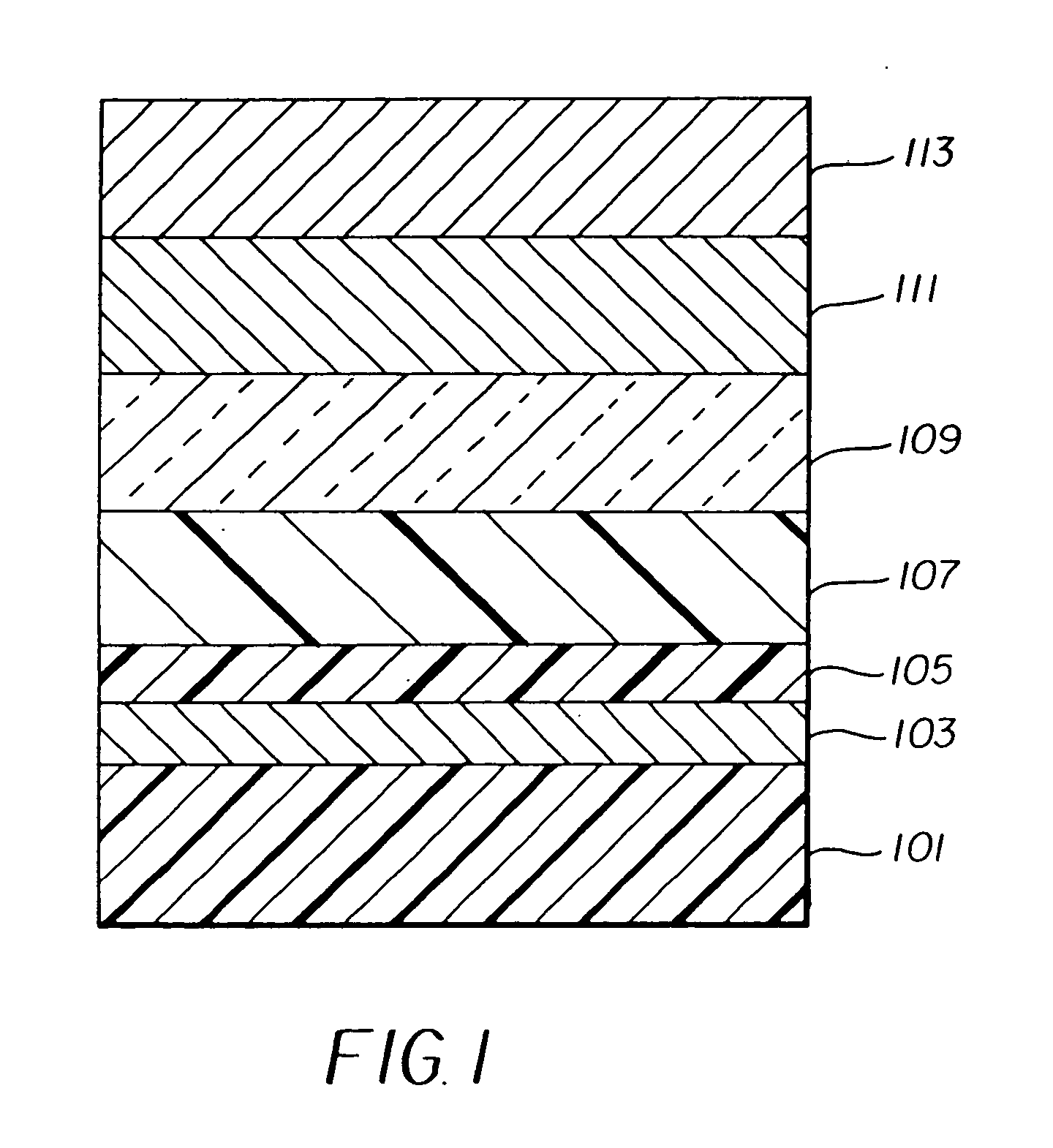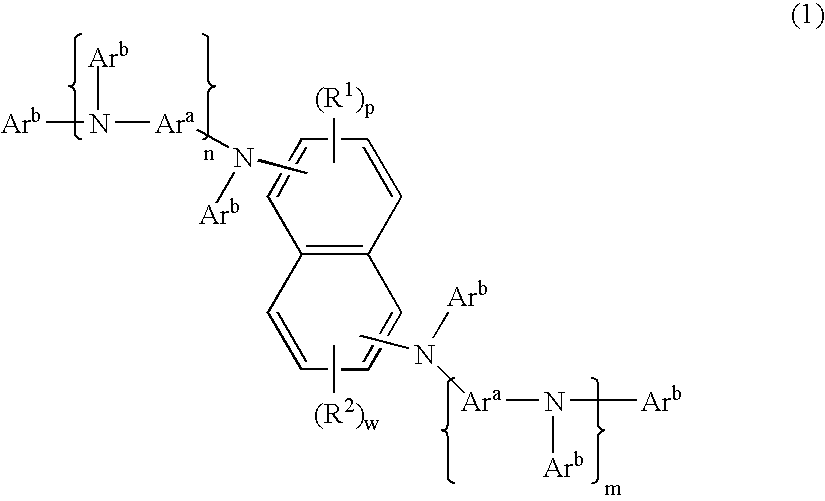Organic element for electroluminescent devices
a technology of electroluminescent devices and organic elements, which is applied in the direction of organic semiconductor devices, discharge tube luminescnet screens, natural mineral layered products, etc., can solve the problems of low oxidation potential of materials, thermal instability, and inability to meet the requirements of many applications, and achieve long operating lifetime and high luminance
- Summary
- Abstract
- Description
- Claims
- Application Information
AI Technical Summary
Benefits of technology
Problems solved by technology
Method used
Image
Examples
synthesis example 1
Preparation of Inv-7
[0152] N,N,N′-Triphenyl-1,5-diaminonaphthalene was prepared by combining 1,5-Diaminonaphthalene (16.0 g, 0.101 mol) with bromobenzene (47.1 g, 0.300 mol), palladium diacetate (1.2 g, 0.004 mol), tri-t-butylphosphine (4 mL), sodium t-butoxide (24.0g, 0.26 mol), and xylene (400 mL). The mixture was heated at 140° C. with magnetic stirring under a nitrogen atmosphere. After 15 h, an additional amount of palladium diacetate (0.100 g, 0.0004 mol) was added. After heating for another 6 h, more palladium diacetate (0.100 g, 0.0004 mol) was added. After heating for another 15 h the heat was removed. After cooling to room temperature, the solid present was filtered off and the filtrate was purified by column chromatography. This afforded 6.0 g (15% yield) of N,N,N′-triphenyl-1,5-diaminonaphthalene.
[0153] 1,5-dibromo-2,6-di-t-butylnapthalene was prepared from 2,6-Di-t-butylnaphthalene (see R. Harvey, J. Pataki, C. Cortez, P. Di Raddo, C. Yang, J. Org. Chem., 56, 1210 (19...
synthesis example 2
Preparation of Inv-1
[0155] Compound Inv-1 was prepared by combining N-α-naphthyl, N-β-naphthylamine (2.0 g, 7.4 mmol), 1,5-dibromo-2,6-di-t-butylnaphthalene (1.5 g, 3.77 mmol) palladium diacetate (0.110 g, 0.5 mmol), tri-t-butylphosphine (ca. 0.4 mL), sodium t-butoxide (0.85 g, 9.2 mmol), and toluene (40 mL) in a 100 mL round-bottomed-flask under nitrogen and with magnetic stirring. The reaction mixture was heated at reflux and after 1 h, 0.4 mL of tri-t-butylphosphine was added and heating was continued, after a total of 4 h, 150 mg of palladium diacetate was added and the reaction mixture was heated for 16 h. Palladium diacetate (150 mg) was added and heating was continued for 3.5 h. The heat was removed and the reaction mixture was stirred for 60 h. Palladium diacetate (50 mg) was then added and the reaction mixture was heated at reflux for 4 h. The heat was removed and, after cooling, solid material was filtered off. The filtrate was evaporated and the solid obtained was dissol...
example 1
DEVICE EXAMPLE 1
[0156] An EL device (Sample 1) satisfying the requirements of the invention was constructed in the following manner: [0157] 1. A glass substrate coated with an 85 nm layer of indium-tin oxide (ITO) as the anode was sequentially ultrasonicated in a commercial detergent, rinsed in deionized water, degreased in toluene vapor and exposed to oxygen plasma for about 1 min. [0158] 2. Over the ITO was deposited a 1 nm fluorocarbon (CFx) hole-injecting layer (HIL) by plasma-assisted deposition of CHF3. [0159] 3. A first hole-transporting layer (HTL)of Inv-1 having a thickness of 75 nm was then evaporated from a tantalum boat. [0160] 4. A 37.5 nm light-emitting layer (LEL) of tris(8-quinolinolato)aluminum(III) (AlQ3) and dopant DPQ (0.6 wt %, see structure below) were then deposited onto the hole-transporting layer. These materials were also evaporated from tantalum boats. [0161] 5. A 37.5 nm electron-transporting layer (ETL) of tris(8-quinolinolato)aluminum(II) (AlQ3) was the...
PUM
| Property | Measurement | Unit |
|---|---|---|
| thick | aaaaa | aaaaa |
| operating voltages | aaaaa | aaaaa |
| thickness | aaaaa | aaaaa |
Abstract
Description
Claims
Application Information
 Login to View More
Login to View More - R&D
- Intellectual Property
- Life Sciences
- Materials
- Tech Scout
- Unparalleled Data Quality
- Higher Quality Content
- 60% Fewer Hallucinations
Browse by: Latest US Patents, China's latest patents, Technical Efficacy Thesaurus, Application Domain, Technology Topic, Popular Technical Reports.
© 2025 PatSnap. All rights reserved.Legal|Privacy policy|Modern Slavery Act Transparency Statement|Sitemap|About US| Contact US: help@patsnap.com



